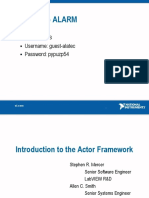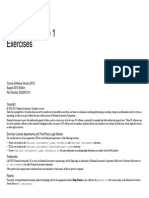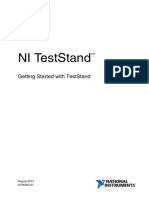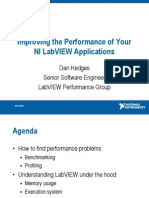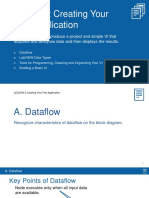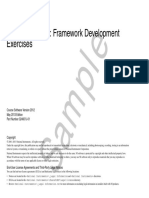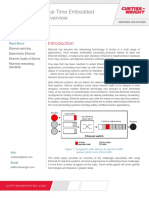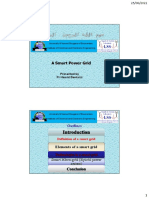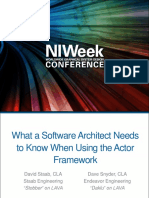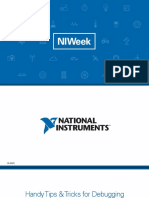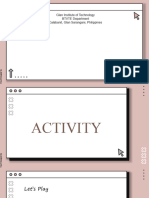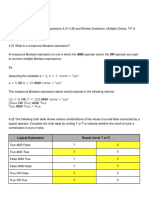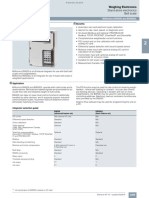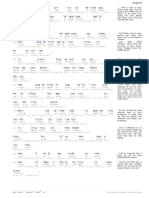ni.
com
�What a Software Architect Needs
to Know When Using the Actor
Framework
David Staab, CLA
Staab Engineering
Stobber on LAVA
ni.com
Dave Snyder, CLA
Endeavor Engineering
Daklu on LAVA
�Two-Part Session
Part 1: Principles of Actor Oriented Design
Learn how to think about actors
Learn how to apply the actor model in general LabVIEW code
Part 2: Making the Actor Framework work for you
ni.com
Learn how to customize framework to achieve common design
goals
3
�Part I
Fundamentals of Actor-Oriented Design (AOD)
Actor Model Theory
What is the Actor Model?
Three elements of the model
Principles that apply to all Actors
Actor system topologies
Applying AOD in LabVIEW
Mapping model elements to code
Tips when implementing Actors
ni.com
�Actor Model Theory
ni.com
�Actor Theory
What is the Actor Model?
The Actor model in computer science is a
mathematical model of concurrent computation
that treats actors as the universal primitives of
concurrent digital computation.
Wikipedia
Translation: Its a way of thinking about and
understanding concurrency.
ni.com
�Actor Theory
Elements of the Actor Model
An encapsulation of data,
procedures, and threads
Actor
Msg
Actor
Message
Any information passing
between actors
Addr
Address
A label indicating message
destination
ni.com
�Actor Theory
Actor Principle #1
Actors can receive any message at any time
An actor has no control over
who has its address
Each actor sends msgs on
its own schedule
A1
A1
A2
A1
A1
Actors must react to unexpected
messages gracefully
ni.com
!!
A3
A4
�Actor Theory
Actor Principle #2
Actors are self-deterministic
Ways to think about it
The actor is responsible for itself
Messages are always requests, never commands
Things are not done to an actor; an actor does things
to itself
If a turkey were an actor, come Thanksgiving we
would ask it to chop off its own head.
Carl Hewitt (paraphrased)
ni.com
�Actor Theory
Actor System Topologies: Starter Options
Direct
Hierarchical
A1
A2
Advantages(?):
Easy to implement
Doesnt require much
A4
A3
planning
Feels very efficient
A1
Advantages:
Promotes encapsulation
A3
A2
Easier to reason about
the behavior
Better scalability
A4
A5
A5
ni.com
10
�Actor Theory
Summary
Actors encapsulate data, procedures, and
threads
Actors cannot predict the next message
Actor Design != Actor System Design
ni.com
11
�Applying AOD to LabVIEW
ni.com
12
�AOD in LV
Implementing Messages: Options
Command
Pattern
Name/Data
Msg
Do.vi
MyMsg
Do.vi
Commonly implemented as
clusters
Msgs are stringly typed
Message and msg handling
code are separate
Requires classes to
implement
Msgs are strongly typed
Message contains msg
handling code
Each option has natural strengths.
Neither option has insurmountable technical limitations.
ni.com
13
�AOD in LV
Implementing Addresses
Addresses = Message Transport
(Queue, User Events, etc.)
but Dave
An address defines a location. Transports move
messages around. Theyre not the same.
The Actor Model is a model
ni.com
14
�AOD in LV
Implementing Actors
Actor Brain = Message Handling Loop (MHL)
DQ Msg
= QMH?
Names convey information about how
the thing is used. Actor != QMH
ni.com
15
�AOD in LV > Actors
Sidebar: Comparing Common QMH and Actor
Common QMH
Actor
Dumb parallel process
Smart parallel process
Focus on sequencing
procedures
Focus on accomplishing
tasks
Puts responsibility on msg
sender (developer)
Takes responsibility for itself
Often thread unsafe
Thread safe
Scales poorly
Scales well
Encourages writing code
quickly
Encourages writing code
robustly
ni.com
16
�AOD in LV > Actors > MHL
Tip #1
Each MHL is a new actor
ni.com
Behaviors define actor, not artifacts (VI, lvlib, etc.)
Multiple MHL on one block diagram is fine
MHL is the actors public interface
Usually maintains all actor state data
17
�AOD in LV > Actors > MHL Tip 1
UI Block Diagram
Four Actors
ni.com
18
�AOD in LV > Actors > MHL
Tip #2
Each actor entails
development overhead
All actors need
Exit conditions
Error handling
Implement these features FIRST
ni.com
19
�AOD in LV > Actors > MHL Tip 2
Actor Development Overhead
My MHL Template
DQ Msg
Create
Queue
ni.com
Destroy Queue
20
�AOD in LV > Actors > MHL
Tip #3
Not All Loops Are Actors
Some processes are not conducive to MHL
Delegate to Helper Loops
ni.com
E.g. Continuous processes, periodic processes
No message handler
Limited self-determinism
Does one task well
Not a shared resource
21
�AOD in LV > Actors > MHL Tip 3
Helper Loop Metronome
ni.com
22
�AOD in LV > Actors > MHL
Tip #4
Actors work best when the
MHL has to wait
Msg processing time << Time between msgs
MHL should handle every message instantly
Dont use it as a job queue
Priority messages are unnecessary
Manipulating the message transport
is a Code Smell
ni.com
23
�AOD in LV > Actors > MHL Tip 4
Helper Loop Job Processor
ni.com
24
�AOD in LV > Actors
Message Handling Loop Tips
Each MHL is a new actor
Each actor entails development overhead
Not all loops are actors Helper Loops
Actors work best when the MHL has to wait
If the MHL is the actors brain, helper loops and
sub actors are the arms and legs doing the
heavy lifting.
ni.com
25
�If nothing else, remember this
AOD requires changing how you think
Its not the same as QMH/QSM thinking
Dont try to do too much in your MHL
Delegate to sub actors and helper loops
Actors can receive any message at any time
ni.com
Make sure you implement them that way
26
�Part II
Making the Actor Framework Work for You
1.
2.
3.
4.
5.
6.
7.
ni.com
Actor Framework review
How to communicate with actors
How to implement state
How to handle or report errors
How to stop actors
How to debug actors
How to deploy actors
27
�Actor Framework Review
ni.com
28
�Actor Framework Review
Actor Framework Features
Uses Inversion of Control (IOC) to guarantee safe
execution
Several features for advanced applications
Priority Queues for inter-actor communication
o
Actors address is its queue refnum
MHL provided by the framework
Actors are launched dynamically
Actors are multi-instanced
Default error handling scheme
All these features come with the framework; cannot
smorgasbord!
ni.com
29
�Actor Framework Review
Messaging Actors
MHL uses the Command Pattern; messages are objects
ni.com
All messages inherit from
AF:Message.lvclass
30
�Actor Framework Review
Common Actor Life Cycle (part 1)
= Framework component
= Optional override
ni.com
31
�Actor Framework Review
Common Actor Life Cycle (part 2)
= Framework component
= Optional override
ni.com
32
�How to Communicate with Actors
ni.com
33
�How to Communicate with Actors
VI Call Hierarchy
Senders are Coupled to Receivers
No way to completely decouple
actors in AF
Msg class library always links them
in at least one direction.
Actor 1.Method A.vi
ni.com
34
�How to Communicate with Actors
Loosen Coupling via Actor Hierarchy
Design Msg:Do.vi to work on abstract actor type
If message has no payload, could be Actor.lvclass
If message has payload, need abstract actor with method
Allows sender to choose its receiver
Msg:Do.vi
ni.com
35
�How to Communicate with Actors
Loosen Coupling via Message Hierarchy
Abstract data (payload)
Concrete method (action)
Can change message on
receivers interface at runtime
Allows receiver to choose
message
ni.com
36
�How to Communicate with Actors
Messaging Outside the Framework
Frameworks tend to be viral in a design
AF actors send messages to callers via priority queue.
Msg:Send.vi
ni.com
AF actors want their callers to be AF actors.
Non-AF caller of an AF actor must either ignore messages or
implement its own MHL for the priority queue.
37
�How to Communicate with Actors
Minimal MHL for non-AF caller
MyCallerMHL.vi
ni.com
38
�How to Communicate with Actors
Calling Actor Methods Synchronously
Reply Msg.lvclass allows synchronous code to call
actors (command/response)
Timeout condition only tells whether actor processed msg
Condition
Indication
Error
~Error &&
Msg not sent
Timeout
~Error && ~Timeout
ni.com
Msg not executed or failed
??? (Executed? Cached? Ignored?)
39
�How to Communicate with Actors
Enhanced Reply Msg
MyReplyMessage:Do Core.vi
Example:
Add ACK
to Reply
MyActor:Shut Down.vi
ni.com
40
�How to Communicate with Actors
Enhanced Reply Msg Benefits
Add ACK output from Reply Msgs to report whether
message executed.
Condition
Indication
Error
~Error &&
Msg not sent
Timeout
~Error && ~Timeout &&
Msg not executed or failed
ACK
Msg executed normally
~Error && ~Timeout && ~ACK
Msg ignored or cached
ACK also reports whether other data in Reply output is
valid.
Condition
Indication
~ACK
Reply value invalid
ACK
ni.com
Reply value valid
41
�How to Implement State
ni.com
42
�How to Implement State
Working with Shared Reentrancy
All AF actors are launched dynamically using ACBR node
LV uses a pool of clones for shared reentrant VIs
Msg:Do.vi is shared reentrant So are your actor methods
No certainty in which clone will be used on each call
Must avoid storing state in a shared reentrant method.
Cannot use these elements:
ni.com
Uninitialized shift registers
Feedback nodes
UI code that assumes Front Panel will be in default state
<vi.lib> functions that cache state
43
�How to Implement State
Store Actor State in Object Parameters
Object wire is stored in MHLs shift register
Every message method has access to wire
state data
non-state data
Recommend using clusters to organize complex object
data
ni.com
44
�How to Implement State
Remove State from SubVIs
<vi.lib> Peak Detector.vi
ni.com
45
�How to Implement State
Remove State from SubVIs
Stateless Peak Detector.vi
ni.com
46
�How to Implement State
Remove State from SubVIs
MyActor:Find Peaks.vi
ni.com
47
�How to Handle or Report Errors
ni.com
48
�How to Handle or Report Errors
Default Framework Behavior
All message errors are handled by the framework.
1.
2.
3.
4.
Message method generates error
Handle Error.vi always stops the actor (by default)
Last Ack Msg is sent to caller (not shown)
Caller reads error from LA Msg and throws it to itself
o
GOTO 1
AF:Actor:Actor Core.vi
AF:Actor:Handle Last Ack Core.vi
ni.com
49
�How to Handle or Report Errors
Customizing Error Handling
Define non-default behaviors by overriding framework VIs:
Handle Error.vi
Handle Last Ack Core.vi
Report errors to a central handler or logger
Clear locally-scoped errors
Do not insert callees error into own error path
Re-launch callee to attempt graceful error recovery
Make this default for your actors with an override class
e.g. MyActor.lvclass AF_Overrides.lvclass Actor.lvclass
This does not handle errors in helper loops!
ni.com
50
�How to Stop Actors
ni.com
51
�How to Stop Actors
How the Framework Stops an Actor
AF:Stop Msg:Do.vi
Stop Msg.lvclass:Do.vi inserts
an error into the MHL
1.
Handle Error.vi stops the actor
and clears error 43
2.
Error 43 never reported by actor
to its caller
Error 43 is a standard code used by <vi.lib> functions
43: Normal Stop
1608: Emergency Stop
Operation canceled by user
e.g. Open/Create/Replace File.vi: If user cancels a File Browse
operation, actor will stop without error.
Error 1608 is not cleared: all actors in call chain will stop
ni.com
53
�How to Stop Actors
Default Stopping Handshake
Framework defines a handshake for stopping an actor
Common design sends Stop Msg to callees in Stop
Core.vi
Caller sends Stop Msg, actor stops asynchronously
Actor sends Last Ack Msg to caller after it stops
Stop Core executes after MHL breaks
Caller cannot listen for Last Ack Msg from stopped callees
If Last Ack Msg carries an error, caller will not pass error up the
call chain!
Better design avoids stopping caller until Last Ack Msgs
arrive from all callees.
ni.com
54
�How to Stop Actors
Improved Stop Handshake
MyActor:Handle Error.vi
MyActor:Handle Last Ack Core.vi
ni.com
55
�How to Debug Actors
ni.com
56
�How to Debug Actors
The Framework Makes Debugging Harder
Many debugging challenges caused by two facts:
1.
Breakpoints do not work normally on VI clones
2.
3.
ni.com
AF dynamically launches every actor.
AC.vi and Msg:Do.vi are shared reentrant
Saved breakpoints cant be disabled on clones
Breakpoints set on a clone at run-time dont work
Probes set on a reentrant VIs wire (prior to run) dont
show clone data (while running)
Execution highlighting and probes cause bugs and
crashes when used on reentrant VIs in LVRT.
57
�How to Debug Actors
Debugging Workarounds
1.
If actor has no helper loop, develop and test class
without launching it. When tests pass, launch using AF.
2.
Wire True to Show Front Panel input on Launch
Actor.vi
3.
Inspect clone using Highlight Execution and probes
Cant be used on AC.vis inserted into a subpanel
Use NI Desktop Execution Trace Toolkit v2013
ni.com
Can test as a multi-instance class by splitting the wire
Infeasible if class sends AF messages inside its methods
Generate events when actors initialize, start execution, handle an
error, receive a Last Ack Msg, receive a Stop Msg, etc.
Add these traces to your framework override
58
�How to Deploy Actors
ni.com
59
�How to Deploy Actors
Deploying Applications and Compiled Libraries
AF actors are launched dynamically, so an application
needs a launcher VI.
If app uses AF actors for the UI, normally want to close
the launcher when UI finishes initialization.
Might include extra features like error reporting/logging,
controlled shutdown, RPC or CLI, etc.
Make the launcher a Splash Screen
AC.vi is called by ACBR node, so app builder might strip
its front panel from the build.
ni.com
AF requires all AC.vi front panels to execute.
Access a front panel property or value to prevent this.
60
�How to Deploy Actors
Deploying Applications and Compiled Libraries
AF does not work natively with LVLIBP (Packed Project
Libraries)
Must modify the framework
v4.0 can be modified to work, but not v4.1 (shipping with LV)
See NI Community for details:
https://decibel.ni.com/content/message/49089#49089
ni.com
61
�Thanks!
Dave Snyder
dave@meksys.com
David Staab
david@staabengineering.com
ni.com
62
